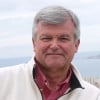The Story of Silent Night
Legacy of a humble Austrian priest
On December 24th, the day before Christmas, in 1818 the young assistant pastor of St. Nicholas Church in the Austrian village of Oberndorf (located about 21 kilometers north of Salzburg - see map below) took a twenty minute walk from the church to the nearby village of Arnsdorf to visit his friend Franz Xaver Gruber. Gruber was a verger (lay minister) and the organist at St. Nicholas. He was also the schoolmaster in Arnsdorf.
The young assistant pastor, Joseph Mohr had been assigned to the newly built St. Nicholas Church a year earlier after poor health had forced his superiors to remove him from his post as assistant pastor in the village of Mariapfarr and hospitalize him in Salzburg. Upon being released from the hospital he was assigned to St. Nicholas Church in Oberndorf where he became good friends with Franz Gruber.
Location of Oberndorf, Austria
Location of St. Nicholas Church in village of Oberndorf, Austria, where assistant pastor, Father Joseph Mohr, composed words for Silent Night
Nearby Village of Arnsdorf where Franz Xaver Gruber, Father Joseph Mohr's friend and the man who Mohr asked to compose the music for Silent Night
City of Salzburg, the Austrian city located about 20 miles southeast of Village of Oberndorf
Gruber and Mohr Collaborate on the Carol
Like Gruber, Mohr had studied music. Mohr played the guitar and wrote spiritual poetry in his spare time to relax. The purpose of the December 24th visit to Gruber's home was to ask a favor. In his hand was a poem he had written while ministering in Mariapfarr. Now, he wanted Gruber to put the poem to music so it could be sung at the Christmas Eve Midnight Mass that night.
According to a later written account by Gruber, Mohr requested that Gruber "compose a suitable melody for two solo voices with choir and the accompaniment of one guitar". Gruber wrote the desired melody and at Mass that evening the parishioners heard the beautiful carol that we know as "Silent Night" performed for the first time.
No one knows what inspired Fr. Joseph to write "Stille Nacht! Heilige Nacht!". We also don't know why he requested that the melody be written for guitar other than the fact that Fr. Joseph enjoyed playing the guitar. The story about Fr. Joseph having written the carol and performing it with his guitar because the church organ was broken (some versions had the cause as mice having chewed through the bellows making the organ inoperable) has been proved to be nothing more than a fictional embellishment by later day romantics.
Fr. Joseph Mohr was transferred from St. Nicholas parish in Oberndorf a year latter. He served in a number of different parishes and in 1838 was appointed pastor in the Alpine village of Wagrain where he served until his death on December 4, 1848. He was buried in the churchyard in Wagrain.
Throughout his life Fr. Mohr remained a humble priest. He always described his collaboration with Franz Gruber to produce "Silent Night" that December 24th as one of the best times in his life and always gave credit to Franz Gruber saying, "The two of us did something for the Holy Night. I transcribed the words and Franz Gruber the melodie,"
While the story about the carol being created because the organ was broken is fictitious, the reason for the carol reaching the outside world has to do with a problem with the organ. On one of his regular visits to Oberndorf Karl Mauracher, a renowned organ builder who traveled regularly throughout the area building and repairing church organs, obtained a copy of "Silent Night". We don't know whether a copy was given to him or if he saw a sheet with the music laying near the organ and copied it. But he did obtain a copy and took it home with him and gave it to the Rainers and the Strassers, two families of folk singers who made a living traveling throughout the region around Innsbruck giving musical performances. "Silent Night" was added to the collection of songs they performed and the world was slowly introduced to this beautiful carol.
The carol became known throughout the region and, in 1834 the Strassers performed it for King Frederick William IV of Prussia. The king was so taken with the carol that he commanded that his cathedral choir sing it every Christmas and this brought it to the attention of the rest of the world. In 1839 the Rainers came to America on tour and sung "Silent Night" outside historic Trinity Church in New York.
Today Fr. Joseph's lovely carol is sung and enjoyed throughout the world.
Silent Night
Silent night Holy night
All is calm all is bright
'Round yon virgin Mother and Child
Holy infant so tender and mild
Sleep in heavenly peace
Sleep in heavenly peace
Silent night, holy night,
Shepherds quake at the sight.
Glories stream from heaven afar,
Heav'nly hosts sing Alleluia;
Christ the Savior is born;
Christ the Savior is born.
Silent night, holy night,
Son of God, love's pure light.
Radiant beams from Thy holy face,
With the dawn of redeeming grace,
Jesus, Lord, at Thy birth;
Jesus, Lord, at Thy birth.
Stille Nacht! Heilige Nacht!
Stille Nacht! Heil'ge Nacht! Alles schläft; einsam wacht Nur das traute hoch heilige Paar.
Holder Knab' im lockigten Haar,
Schlafe in himmlischer Ruh!
Stille Nacht! Heil'ge Nacht! Gottes Sohn, o wie lacht Lieb' aus deinem göttlichen Mund,
Da uns schlägt die rettende Stund'.
|Jesus in deiner Geburt!
Stille Nacht! Heil'ge Nacht! Die der Welt Heil gebracht, Aus des Himmels goldenen Höhn,
Uns der Gnaden Fülle läßt sehn,
Jesus in Menschengestalt!
© 2006 Chuck Nugent










